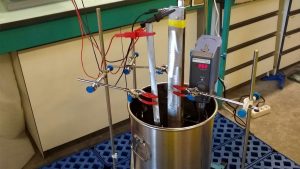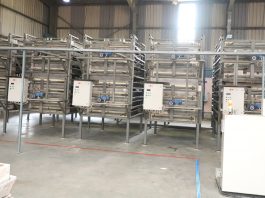Researchers from Chalmers University of Technology have been developing a method to reduce mercury emissions from industry.
Their method has been successful, and they have reduced mercury emissions from industry by over 90% — even from low levels.
Mercury is found in the common pollutant, sulphuric acid. It is the world’s most used chemical and is important in many industries, including paper, pharmaceuticals, batteries, and cosmetics.
Sulphuric acid is produced either from sulphur from the petroleum industry or as a by-product in the mining industry’s smelters. In the latter case, mercury, which is naturally present in the ore, can end up in the finished products.
Therefore, reducing toxic mercury emissions in sulphuric acid has become a worldwide challenge.
The research, ‘Mercury Removal from Concentrated Sulfuric Acid by Electrochemical Alloy Formation on Platinum,’ is detailed in ES&T Engineering.
Mercury emissions from industry are fatal, experts warn
Mercury dispersal is a global problem, as the substance is volatile and can be dispersed by air over large areas.
Mercury emissions from industry are washed into streams and lakes when it rains. Then, it is stored in soil, water and living organisms, which impacts the entire food chain and damages the health of humans and animals.
According to a report from the United Nations Environment Programme (UNEP), the presence of mercury in the atmosphere increased by around 20% from 2010 to 2015.
In 2015, about 2,200 tonnes of mercury was emitted into the air due to human activities such as cement manufacture, small-scale gold mining, coal burning, metal production, and other manufacturing industries.
In addition, an estimated 1,800 tonnes of mercury emissions from industry ended up in soil and water in that same year. According to the report, mercury concentrations in the atmosphere may have increased by a staggering 450% in the last century.

Björn Wickman, Associate Professor at the Department of Physics at Chalmers and leader of the research, explained: “Any way we can reduce mercury emissions is good because any mercury that is emitted accumulates in the environment and continues to pose a health threat for thousands of years.”
How does electrochemistry capture pollutants?
This method uses a metal electrode that picks up the toxic metal and forms an alloy. This means that mercury emissions from industry can be safely removed, and the electrode can be reused.
Recently, the team took this method a step further, showing how mercury can be removed from concentrated sulphuric acid.
The experiments with sulphuric acid were done in collaboration with mining and metals refining company, Boliden, and Atium, a company that hopes to bring mercury removal from water and chemicals to market.
The researchers now hope to be able to move forward with their partners and develop a type of reactor through which sulphuric acid can flow and be purified at the same time.
Wickman stated:
“Until now, there has been no viable method for purifying finished sulphuric acid. With such a radical reduction in the mercury content, we come well below the current limit values,”
“Such pure, high-quality sulphuric acid is in high demand in industrial applications and an important step in reducing environmental impact.”

The method could reduce the costs and environmental impact of mercury removal
Usually, removing mercury emissions from industry is done earlier, from the concentrates and recycled streams at the smelter before sulphuric acid is produced.
This process is established but leaves trace amounts of mercury in the final products.
Vera Roth, a doctoral student at Chalmers and first author of the paper, said: “Purifying the sulphuric acid prevents additional mercury emissions while allowing industry to operate more cost-effectively and produce a high-purity, non-toxic product.
She concluded: “The next step will be to scale up the method into a pilot process that is closer to real-world volumes of thousands of tonnes.”









